Rajya Sabha
Coordinates: 28°37′0″N 77°12′30″E / 28.61667°N 77.20833°E
| Rajya Sabha Council of States | |
|---|---|
 | |
| Type | |
| Type |
Upper house of the Parliament of India |
Term limits | 6 years |
| Leadership | |
| Structure | |
| Seats |
245 (233 Elected + 12 Nominated by the President) 1 Vacant (1 Elected Seat)[3] |
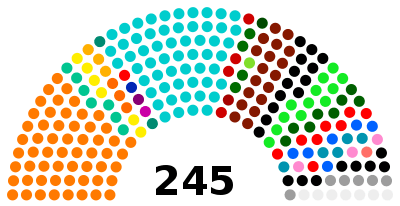 | |
Political groups |
Government coalition (89) Opposition (155) Other Parties (82)
Others (10)
Vacant (1)
|
| Elections | |
| Single transferable vote | |
Last election | 16 January, 23 March and 21 June 2018 |
Next election | May - June 2019 |
| Meeting place | |
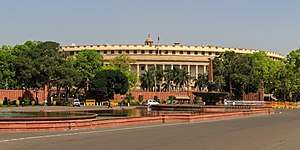 | |
|
Chamber of Rajya Sabha, Sansad Bhavan, Sansad Marg, New Delhi, India | |
| Website | |
|
rajyasabha | |
The Rajya Sabha or Council of States is the upper house of the Parliament of India. Membership of Rajya Sabha is limited by the Constitution to a maximum of 250 members, and current laws have provision for 245 members. Most of the members of the House are indirectly elected by state and territorial legislatures using single transferable votes, while the President can appoint 12 members for their contributions to art, literature, science, and social services. Members sit for staggered six-year terms, with one third of the members retiring every two years.[4]
The Rajya Sabha meets in continuous sessions, and unlike the Lok Sabha, the lower house of Parliament, is not subject to dissolution. However, the Rajya Sabha, like the Lok Sabha can be prorogued by the President. The Rajya Sabha has equal footing in all areas of legislation with Lok Sabha, except in the area of supply, where the Lok Sabha has overriding powers. In the case of conflicting legislation, a joint sitting of the two houses can be held. However, since the Lok Sabha has twice as many members as the Rajya Sabha, the former would normally hold the greater power. Joint sittings of the Houses of Parliament of India are rare, and in the history of the Republic, only three such joint-sessions have been held; the latest one for the passage of the 2002 Prevention of Terrorism Act.
The Vice President of India (currently, Venkaiah Naidu) is the ex-officio Chairman of the Rajya Sabha, who presides over its sessions. The Deputy Chairman, who is elected from amongst the house's members, takes care of the day-to-day matters of the house in the absence of the Chairman. The Rajya Sabha held its first sitting on 13 May 1952.[5] The salary and other benefits for a member of Rajya Sabha are same as for a member of Lok Sabha.
Rajya Sabha members are elected by state legislatures rather than directly through the electorate by single transferable vote method. From 18 July 2018, Rajya Sabha MPs can speak in 22 Indian languages in House as the Upper House has facility for simultaneous interpretation in all 22 Indian languages.[6]
Qualifications
Article 84 of the Constitution lays down the qualifications for membership of Parliament. A member of the Rajya Sabha must:[7]
- Be a citizen of India.
- Make and subscribe before some person authorized in that behalf by the Election Commission an oath or affirmation according to the form set out for the purpose in the Third Schedule to the Constitution.
- Be at least 30 years old.
- Be elected by the Legislative Assembly of States and Union territories by means of Single transferable vote through Proportional representation.[8]
- Not be a proclaimed criminal.
- Not be an subject of insolvent, i.e. he/she should not be in debt that he/she is not capable of repaying in a current manner and should have the ability to meet his/her financial expenses.
- Not hold any other office of profit under the Government of India.
- Not be of unsound mind.
- Possess such other qualifications as may be prescribed in that behalf by or under any law made by Parliament.
In addition, twelve members are nominated by the President of India having special knowledge in various areas like arts and science. However, they are not entitled to vote in Presidential elections as per Article 55 of the Constitution.
Limitations
The Constitution of India places some restrictions on Rajya Sabha which makes Lok Sabha more powerful in certain areas of comparison.
Money bills
The definition of a money bill is given in article 110 of constitution of India. A money bill can be introduced only in the Lok Sabha by a minister and only on recommendation of President of India. When the Lok Sabha passes a money bill then the Lok Sabha sends money bill to the Rajya Sabha for 14 days during which it can make recommendations. Even if Rajya Sabha fails to return the money bill in 14 days to the Lok Sabha, that bill is deemed to have passed by both the Houses. Also, if the Lok Sabha rejects any (or all) of the amendments proposed by the Rajya Sabha, the bill is deemed to have been passed by both Houses of Parliament of India in the form the Lok Sabha finally passes it. This is because the Lok Sabha has largest number of representatives of peoples of India and so the Lok Sabha, the lower house is more powerful in comparison with Rajya Sabha, the upper house. Hence, Rajya Sabha can only give recommendations for a money bill but Rajya Sabha cannot amend a money bill this is to ensure that Rajya Sabha must not add any non money matters in money bill. Lok Sabha can reject all the recommendations of Rajya Sabha or can accept some or all of the recommendations. Decisions of the speaker of the Lok Sabha are final. There is no joint sitting of both the houses with respect to money bills, because all final decisions are taken by the Lok Sabha.[9]
Joint Sitting of the Parliament
Article 108 provides for a joint sitting of the two Houses of Parliament in certain cases. A joint sitting can be convened by the President of India when one house has either rejected a bill passed by the other house, has not taken any action on a bill transmitted to it by the other house for six months, or has disagreed to the amendments proposed by the Lok Sabha on a bill passed by it. Considering that the numerical strength of Lok Sabha is more than twice that of Rajya Sabha, Lok Sabha tends to have a greater influence in a joint sitting of Parliament. A joint session is chaired by the Speaker of Lok Sabha. Also, because the joint session is convened by the President on advice of the government, which already has a majority in Lok Sabha, the joint session is usually convened to get bills passed through a Rajya Sabha in which the government has a minority.
Joint sessions of Parliament are a rarity, and have been convened three times in last 71 years, for the purpose of passage of a specific legislative act, the latest time being in 2002:
- 1961: Dowry Prohibition Act, 1958
- 1978: Banking Services Commission (Repeal) Act, 1977
- 2002: Prevention of Terrorism Act, 2002
No-confidence motion
Unlike the Lok Sabha, a member of the Rajya Sabha cannot bring to the house a no-confidence motion against the government.
Powers
In Indian federal structure, Rajya Sabha is a representative of the States in the Union legislature (Hence the name, Council of States). Hence, Rajya Sabha is granted powers that protect the rights of States against the Union.
Union-States Relations
The Constitution empowers Parliament of India to make laws on the matters reserved for States (States List). However, this can only be done if Rajya Sabha first passes a resolution by two-thirds special majority granting such a power to the Union Parliament. The union government cannot make a law on a matter reserved for states without any authorisation from Rajya Sabha.
Creation of All-India Services
Rajya Sabha, by a two-thirds super majority can pass a resolution empowering the Government of India to create more All-India Services common to both Union and States, including a judicial service.
Composition
Seats are allotted in proportion to the population of people of each state or union territory in such a manner that smaller states have slight advantage over more populous states.[10] As the members are elected by the state legislature, smaller Union Territories which are not States and do not have legislatures cannot have representation in Rajya Sabha. Hence, Andaman and Nicobar Islands, Lakshadweep, Chandigarh, Daman and Diu & Dadra and Nagar Haveli do not send any representatives to Rajya Sabha. 12 members are nominated by the President.[11][12]
As per the Fourth Schedule to the Constitution of India on 26 January 1950, the Rajya Sabha was to consist of 216 members of which 12 members were to be nominated by the President and the remaining 204 elected to represent the States.[12] The present strength, however, is 245 members of whom 233 are representatives of the states and union territories and 12 are nominated by the President.[12] The 12 nominated members of the Rajya Sabha are persons who are eminent in particular fields, and are well known contributors in the particular field.
List of constituencies by States/Union Territories
| State and Union Territory | Seats |
|---|---|
| Andhra Pradesh[13] | 11 |
| Arunachal Pradesh | 1 |
| Assam | 7 |
| Bihar | 16 |
| Chhattisgarh | 5 |
| Goa | 1 |
| Gujarat | 11 |
| Haryana | 5 |
| Himachal Pradesh | 3 |
| Jammu and Kashmir | 4 |
| Jharkhand | 6 |
| Karnataka | 12 |
| Kerala | 9 |
| Madhya Pradesh | 11 |
| Maharashtra | 19 |
| Manipur | 1 |
| Meghalaya | 1 |
| Mizoram | 1 |
| Nagaland | 1 |
| National Capital Territory of Delhi | 3 |
| Nominated | 12 |
| Odisha | 10 |
| Puducherry | 1 |
| Punjab | 7 |
| Rajasthan | 10 |
| Sikkim | 1 |
| Tamil Nadu | 18 |
| Telangana[13] | 7 |
| Tripura | 1 |
| Uttar Pradesh | 31 |
| Uttarakhand | 3 |
| West Bengal | 16 |
| Total | 245 |
Membership by party
Members of Rajya Sabha by their political party (As of 1 October 2018):[14]
| Alliances | Party | MP |
|---|---|---|
| National Democratic Alliance Seats: 89 |
Bharatiya Janata Party | 73 |
| Janata Dal (United) | 6 | |
| Shiromani Akali Dal | 3 | |
| Shiv Sena | 3 | |
| Bodoland People's Front | 1 | |
| Naga People's Front | 1 | |
| Republican Party of India (A) | 1 | |
| Sikkim Democratic Front | 1 | |
| United Progressive Alliance Seats: 57 |
Indian National Congress | 50 |
| Dravida Munnetra Kazhagam | 4 | |
| Indian Union Muslim League | 1 | |
| Janata Dal (Secular) | 1 | |
| Kerala Congress (M) | 1 | |
| Janata Parivar Alliance Seats: 6 |
Rashtriya Janata Dal | 5 |
| Indian National Lok Dal | 1 | |
| Other Parties Seats: 82 |
All India Anna Dravida Munnetra Kazhagam | 13 |
| All India Trinamool Congress | 13 | |
| Samajwadi Party | 13 | |
| Biju Janata Dal | 9 | |
| Telugu Desam Party | 6 | |
| Telangana Rashtra Samithi | 6 | |
| Communist Party of India (Marxist) | 5 | |
| Bahujan Samaj Party | 4 | |
| Nationalist Congress Party | 4 | |
| Aam Aadmi Party | 3 | |
| Communist Party of India | 2 | |
| Jammu and Kashmir Peoples Democratic Party | 2 | |
| YSR Congress Party | 2 | |
| Independents | 6 | |
| Nominated | 4 | |
| Vacant Seats | 1 Seat from Bihar | 1 |
| Total | 245 |
Officers
Leader of the House
Besides the Chairman (Vice-President of India) and the Deputy Chairman, there is also a position called Leader of the House. This is a cabinet minister – the Prime Minister if he is a member of the House, or another nominated Minister. The Leader has a seat next to the Chairman, in the front row.
Leader of the Opposition
Besides the Leader of the House, who is leading the majority, there is also a Leader of the Opposition (LOP) – leading the opposition parties. The function was only recognized in the Salary and Allowances of Leaders of the Opposition in Parliament Act 1977. This is commonly the leader of the largest non-government party, and is recognized as such by the Chairman.
The following people have been the Leader of the Opposition in the Rajya Sabha:
| Sr No | Name | Portrait | Term of office | Political party (Alliance) |
Prime Minister | |||
|---|---|---|---|---|---|---|---|---|
| 1 | Shyam Nandan Mishra | December 1969 | March 1971 | INC (O) | Indira Gandhi | |||
| 2 | M. S. Gurupadaswamy | March 1971 | April 1972 | |||||
| 3 | Kamalapati Tripathi | 30 March 1977 | 15 February 1978 | INC | Morarji Desai | |||
| 4 | Bhola Paswan Shastri | 24 February 1978 | 23 March 1978 | INC (O) | ||||
| 5 | Kamalapati Tripathi | 23 March 1978 | 8 January 1980 | INC | ||||
| Charan Singh | ||||||||
| 6 | Lal Krishna Advani | 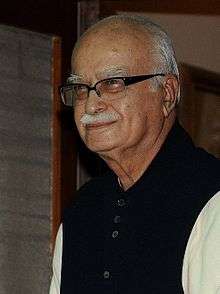 |
21 January 1980 | 7 April 1980 | Janata Party | Indira Gandhi | ||
| 7 | P. Shiv Shankar | 18 December 1989 | 2 January 1991 | INC | V. P. Singh | |||
| Chandra Shekhar | ||||||||
| 8 | M. S. Gurupadaswamy | 28 June 1991 | 21 July 1991 | Janata Dal | P. V. Narasimha Rao | |||
| 9 | S. Jaipal Reddy | 22 July 1991 | 29 June 1992 | |||||
| 10 | Sikander Bakht | 7 July 1992 | 23 May 1996 | BJP | ||||
| 11 | Shankarrao Chavan | 23 May 1996 | 1 June 1996 | INC | Atal Bihari Vajpayee | |||
| 12 | Sikander Bakht | 1 June 1996 | 19 March 1998 | BJP | H. D. Deve Gowda | |||
| I. K. Gujral | ||||||||
| 13 | Manmohan Singh | .jpg) |
21 March 1998 | 21 May 2004 | INC | Atal Bihari Vajpayee | ||
| 14 | Jaswant Singh | 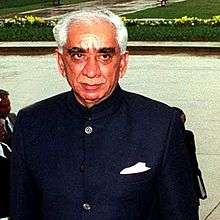 |
3 June 2004 | 16 May 2009 | BJP | Manmohan Singh | ||
| 15 | Arun Jaitley | 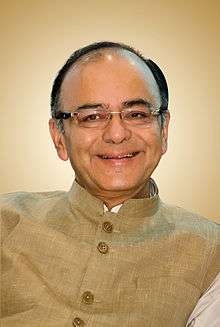 |
3 June 2009 | 26 May 2014 | ||||
| 16 | Ghulam Nabi Azad | 8 June 2014 | Incumbent | INC | Narendra Modi | |||
Secretariat
The Secretariat of Rajya Sabha was set up pursuant to the provisions contained in Article 98 of the Constitution. The said Article, which provides for a separate secretarial staff for each House of Parliament, reads as follows:- 98. Secretariat of Parliament – Each House of Parliament shall have a separate secretarial staff: Provided that nothing in this clause shall be construed as preventing the creation of posts common to both Houses of Parliament. (2) Parliament may by law regulate the recruitment and the conditions of service of persons appointed to the secretarial staff of either House of Parliament.
The Rajya Sabha Secretariat functions under the overall guidance and control of the Chairman. The main activities of the Secretariat inter alia include the following :
(i) providing secretarial assistance and support to the effective functioning of the Council of States (Rajya Sabha) possible to Members of Rajya Sabha; (iv) servicing the various Parliamentary Committees; (v) preparing research and reference material and bringing out various publications; (vi) recruitment of manpower in the Sabha Secretariat and attending to personnel matters; and (vii) preparing and publishing a record of the day-to-day proceedings of the Rajya Sabha and bringing out such other publications, as may be required concerning the functioning of the Rajya Sabha and its Committees.
In the discharge of his constitutional and statutory responsibilities, the Chairman, Rajya Sabha is assisted by the Secretary-General, who holds the rank equivalent[16] to the Cabinet Secretary to the Government of India. The Secretary-General, in turn, is assisted by senior functionaries at the level of Secretary, Additional Secretary, Joint Secretary and other officers and staff of the Secretariat. Present secretary-general is Desh Deepak Sharma, IAS. [15]
Media
Rajya Sabha Television (RSTV) is a 24-hour a day, seven day a week parliamentary TV channel fully owned and operated by the Rajya Sabha. The channel is aimed at providing in-depth coverage and analysis of parliamentary affairs especially the functioning of and developments related to Rajya Sabha. During sessions of Parliament, apart from telecasting live coverage of the proceedings of Rajya Sabha, RSTV presents incisive analysis of the proceedings of the House as well as other day-to-day parliamentary events and developments.[16]
See also
References
- ↑ "Venkaiah Naidu sworn in as Vice-President". The Hindu. New Delhi, India. 11 August 2017. Archived from the original on 9 February 2014.
- 1 2 "RAJYA SABHA – AN INTRODUCTION". rajyasabha.nic.in. Archived from the original on 16 August 2011.
- ↑ "MEMBERS OF RAJYA SABHA (STATE WISE LIST)". Rajya Sabha. 18 July 2018. Archived from the original on 5 February 2014.
- ↑ Deshmukh, Yashwant (11 June 2016). "Crucial polls today: A guide to calculus of Rajya Sabha for dummies". Firstpost. Archived from the original on 19 June 2016. Retrieved 20 June 2016.
- ↑ "OUR PARLIAMENT". Indian Parliament. Archived from the original on 17 May 2011. Retrieved 11 May 2011.
- ↑ "Rajya Sabha MPs can now speak in 22 Indian languages in House".
- ↑ "Council of States (Rajya Sabha) – rajyasabha.in". Archived from the original on 18 June 2012.
- ↑ "HANDBOOK FOR RETURNING OFFICERS – FOR ELECTIONS TO THE COUNCIL OF STATES AND STATE LEGISLATIVE COUNCILS" (PDF). Election Commission of India. 1992. pp. 400–426. Archived (PDF) from the original on 10 January 2017. Retrieved 2 August 2017.
- ↑ "Website of the Rajya Sabha – Legislation".
- ↑ "642 Sidharth Chauhan, Bicameralism: comparative insights and lessons". Archived from the original on 18 May 2015. Retrieved 15 May 2015.
- ↑ "FREQUENTLY ASKED QUESTIONS ABOUT RAJYA SABHA". Indian Parliament. Archived from the original on 24 July 2013. Retrieved 8 December 2012.
- 1 2 3 "Composition of Rajya Sabha – Rajya Sabha At Work" (PDF). rajyasabha.nic.in. Rajya Sabha Secretariat, New Delhi. Archived from the original (PDF) on 5 March 2016. Retrieved 20 October 2015.
- 1 2 "Rajya Sabha members alloted [sic] to Telangana, Andhra Pradesh". The Economic Times. 30 May 2014. Archived from the original on 9 February 2014. Retrieved 21 October 2015.
- ↑ "STRENGTHWISE PARTY POSITION IN THE RAJYA SABHA". Rajya Sabha. 18 July 2018. Archived from the original on 6 June 2017.
- ↑ http://164.100.47.5/newsite/rssorgchart/sg.aspx
- ↑ "About Rajya Sabha TV". Rajya Sabha. Archived from the original on 9 February 2014. Retrieved 19 May 2014.
Further reading
- The Nominated Members of India's Council of States: A Study of Role-Definition J. H. Proctor, Legislative Studies Quarterly, Vol. 10, No. 1, Feb 1985, pp. 53–70.
- Alistair, McMillan. "Constitution 91st Amendment Bill: A Constitutional Fraud?". nuff.ox.ac.uk. Retrieved 19 May 2014.
External links
- Rajya Sabha homepage hosted by the Indian government
- Rajya Sabha FAQ page hosted by the Indian government
- 37 Rajya Sabha members have criminal background: Study – analysis by the Association for Democratic Reforms and National Election Watch
- Nominated members list
- State wise list
- Rajya Sabha Television
- MEMBERS OF RAJYA SABHA (STATE WISE LIST) TN